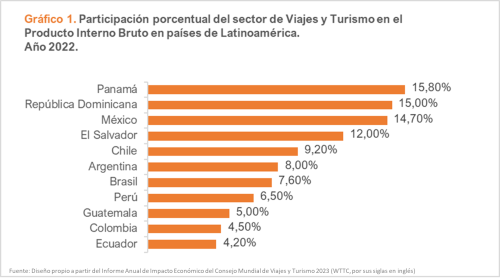
OBS Report: Developments and challenges in the tourism sector in Latin America
Only three Latin American countries have managed to recover their international tourism volumes after the pandemic
- Some Latin American countries achieved a significant recovery in 2022, but not yet at pre-pandemic levels.
- Tourism growth in Latin America and the Caribbean is expected to grow by 1% in 2023.
- 10 countries in the region account for 92% of international tourism and 4 of them account for 72% of international tourism.
July 2023. OBS Business School publishes the report Evolution and challenges of the tourism sector in Latin America, an economic approach in the framework of the post-Covid recovery, directed by collaborator Alexandra Ochoa Vélez. In said report the author presents interesting conclusions such as the fact that by the end of 2022, only three of the 20 countries in the region had surpassed the volume of international tourism prior to pre-pandemic levels. The Dominican Republic, Colombia and El Salvador registered a variation of over 5% in international tourist arrivals. In the case of the Dominican Republic, the number of tourists increased by 43% compared to 2021, while in the case of Colombia, the figure doubled compared to the previous year, making it the third country with the highest number of international tourists in the region in 2022.
Encouraging figures despite challenges in the sector
In 2022, a 77% recovery was achieved in the region compared to 2019 and an average variation of 62% was recorded compared to the previous year, suggesting a recovery trend in the tourism sector.
Data from the World Travel and Tourism Council (WTTC) indicate that tourism's share of the region's GDP is expected to grow moderately, averaging less than 1%. However, the contribution of the tourism sector is measured not only in its direct contribution to GDP, but also in its capacity to generate new opportunities for entrepreneurship and employability in the region. The tourism value chain is broad and complex, encompassing various economic activities such as accommodation, food services, transport, logistics services, entertainment and leisure, among others, which together provide economic development opportunities for the regions. "On average, tourism in the region represents approximately 10 per cent of the economy, if national figures for accommodation, food, beverages and other associated services are considered directly and indirectly," the author points out. In countries such as Panama, the Dominican Republic and Mexico, this share averages around 15% of national GDP.
In terms of revenues from travel and tourism activities, positive results have been observed in most of the countries in the region. Although the number of international travellers has not reached the levels of 2019, in Mexico revenues have experienced a growth of close to 20% in 2022. In addition, Mexico stands out as the country with the highest domestic tourism revenues, with close to USD 163 billion, positioning it as the leader in tourism in the Latin American region. Its contribution to GDP is projected to exceed 16%.
Brazil, Argentina and Chile are also expected to surpass international tourism receipts records in 2023. Panama, with 66% fewer international tourists than Colombia, has recorded similar revenues to its bordering country at US$7.6 billion, which could mean the highest per capita travel and tourism expenditure in the region.
According to data from Colombia's Civil Aeronautics Observatory, air operations have recovered by 91% compared to 2019 and new international routes have been approved, which include Cartagena as a destination. While air operations in terms of flight arrivals have been 8% lower between January and May this year compared to last year, this does not seem to affect non-resident international tourist arrivals, which have increased by 49% in the first quarter of the year.
The future of the sector: projections to 2023
This year is seeing an increase in tourists' confidence in the sanitary measures and safety conditions of destinations. However, it is important to note that the increase in general prices in the economy has led to a rise in the cost of tourism services. Therefore, although a recovery in the volume of tourists is expected, a downward trend in average expenditure per person and average length of stay is forecast.
In terms of seasonality, Mexico, the Dominican Republic, Colombia and Costa Rica are countries that show similar patterns in the behaviour of international tourists. During the months of May and September, there is a decrease in the flow of tourists, while in March, July and December there is a significant increase. These variations are influenced by school holidays and end-of-year festivities.
"With similar comparative advantages, these countries share common characteristics in their focus on sun and beach tourism and nature tourism. However, in order to face the short-term challenges, it is necessary to diversify the tourism portfolio, to specialise and to sophisticate the products offered. This implies providing quality at an affordable price for consumers, considering the international macroeconomic context. In addition, it is important to capture markets with predominant currencies such as the dollar or the euro, taking advantage of current currency prices", recommends Ochoa Vélez.
Based on the performance of the first quarter of the year, the holiday season is expected to surpass last year's records in the region, with an estimated increase of more than 15%. Colombia has experienced a 49% variation in the number of non-resident foreign visitors, while in Mexico international tourist arrivals have increased by 17%. Costa Rica recorded a 33.7% increase compared to the same period last year.
Content Written by:
Jenniffer Zamudio
OBS Business School's Press Office




